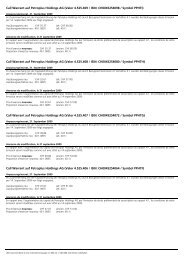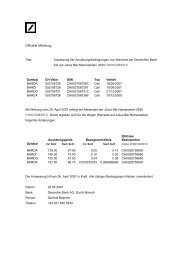Swiss Medtech Report 2012 - Medtech Switzerland
Swiss Medtech Report 2012 - Medtech Switzerland
Swiss Medtech Report 2012 - Medtech Switzerland
- No tags were found...
You also want an ePaper? Increase the reach of your titles
YUMPU automatically turns print PDFs into web optimized ePapers that Google loves.
Invention<br />
Product<br />
Development<br />
From the laboratory to the<br />
marketplace<br />
Though <strong>Switzerland</strong> is a small country it produces a high volume of<br />
cutting edge research and innovative medical therapies. By building<br />
active collaborations across multiple disciplines the <strong>Swiss</strong> medtech<br />
industry exploits its intellectual resources to produce maximum innovation<br />
potential.<br />
CORE sTRENGTHs Many groundbreaking<br />
in novations happen at the interface between engineering,<br />
medicine and biology. To make optimal<br />
use of synergies, the ETHZ founded the Department<br />
Health Sciences and Technology (D-HEST)<br />
in January <strong>2012</strong> to combine teaching and research<br />
in health sciences and medical engineering. Natural<br />
scientists and engineers work together in food and<br />
nutrition science, medical engineering, movement<br />
and sports sciences and neurosciences. The focal<br />
area ‘Technology and Knowledge for Health’ will<br />
be promoted during <strong>2012</strong>–2016 with the transfer of<br />
these topics to hospitals being the final goal.<br />
BRaIN MEETs TECHNOLOGY At the EPFL<br />
in the Laboratory of Cognitive Neuroscience, a mul -<br />
tidisciplinary team of biologists, psychologists, medi -<br />
cal doctors, physicists, engineers and computer scientists,<br />
are investigating the functional and neural<br />
mechanisms of body perception, corporeal awareness<br />
and self-consciousness. They combine psychophysical<br />
and cognitive paradigms with state-of-the-<br />
art neuroimaging techniques. The goals are to develop<br />
neuroscientific models of body perception,<br />
corporeal awareness and self-consciousness by linking<br />
complex phenomenological experience of body<br />
and self to brain mechanisms of multisensory corporeal<br />
perception.<br />
The Blue Brain Project, a co-operation with IBM,<br />
where researchers reconstructed the brain piece by<br />
piece to build a complete virtual brain in a supercomputer,<br />
achieved worldwide recognition. After<br />
five years of work, the team can create realistic models<br />
of processes within the human brain.<br />
At IBM Research Zurich, scientists pursue exploratory<br />
and applied research to pave the way for future<br />
innovations in IT. They collaboratively work on<br />
6<br />
Manufacturing<br />
Facts & Figures<br />
Marketing &<br />
Market Access<br />
Regulation &<br />
Healthcare<br />
Funding &<br />
Financing<br />
pro j e cts to tackle some of the bigger challenges on<br />
our planet. The experimental biosciences team applies<br />
their expertise in micro and nanotechnologies<br />
to solve problems in biology, medicine and life scienc -<br />
es. For instance the team has developed a flexible,<br />
non-contact microfluidic probe made from silicon<br />
which serves as a unique tool to help researchers and<br />
pathologists in investigating critical tissue samples<br />
accurately for disease diagnostics and drug discovery.<br />
The eight-millimeter-wide, diamond-shaped<br />
probe delivers an antibody in a highly specific area<br />
of a tissue. A few picoliters – one trillionth of a liter –<br />
of liquid containing antibodies is sufficient for each<br />
analysis spot.<br />
The CSEM is at the interface between research<br />
and industry. Specialized in micro and nanotechnology,<br />
system engineering, microelectronics and<br />
communication technologies, its scientists and engineers<br />
transfer custom-made innovative solutions<br />
to industry. Transfer examples are portable human<br />
vital signs monitoring systems, point-of-care systems<br />
for multi-parameter biochemical monitoring<br />
or miniaturized sensing, processing and packaging,<br />
and wireless communication technologies to serve<br />
the needs of a non-invasive and mobile healthcare<br />
service. Product concepts for disabled people, such<br />
as artificial retinas, hearing aids and ambient assisted<br />
living-related smart sensors, are increasing in<br />
demand. Future trends are the integration of human<br />
vital signs monitors and biochemical data for mobile<br />
health services, as well as implantable devices<br />
with neurostimulation. Emphasis is placed on mental<br />
and neurological disease monitoring and artificial<br />
organs, such as the artificial kidney, developed<br />
within the European project Nephron.<br />
CLOsE TO CUsTOMERs Besides education<br />
and training, listening closely to SMEs and deliv-




![Formular für nicht regulierte Unternehmen[pdf] - SIX Swiss Exchange](https://img.yumpu.com/21559295/1/184x260/formular-fur-nicht-regulierte-unternehmenpdf-six-swiss-exchange.jpg?quality=85)
![Gastbeitrag[pdf] - SIX Swiss Exchange](https://img.yumpu.com/21558666/1/184x260/gastbeitragpdf-six-swiss-exchange.jpg?quality=85)










